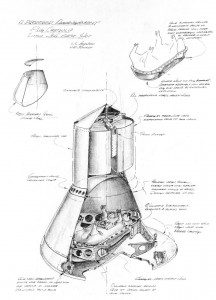Published June 5, 2018
By Ron Miller/io9
As much as we love The Muppets, in 1963 a pair of NASA engineers entertained the idea of sending real pigs into space. This is their story.

“Little Joe” was the name of the rocket used by NASA to test the launch escape system and heat shield of the Mercury capsule. Developed by pioneering spacecraft designer Max Faget, the Little Joe was a cluster of four off-the-shelf Sargeant solid fuel rockets. (The four nozzles seen from below reminded Faget of the double deuce craps throw called a “little Joe” and hence the name.) The Little Joe rocket was capable of lobbing a boiler plate capsule into suborbital ballistic flight. Since the booster was cheap, it was the perfect vehicle for testing the Mercury capsule, which it did very successfully.

On December 4, 1959, a Little Joe rocket shot a rhesus monkey named “Sam” to an altitude of 55 miles — in other words to the very edge of space. (Sam survived the journey, by the way.)
However, in 1963, G.C. Johnson and John W. Wilkey, Jr., who were engineers at NASA’s Langley Research Center, came up with an even more ambitious idea. The suggested replacing the monkey with a pig.
The rationale was that not only was the mass of a pig closer to that of a human, they also share many similar physiological features. Even though the Mercury program had already flown astronauts in sub-orbital and orbital flights, there was still a need for inexpensive tests so Johnson and Wilkey’s plan made some sense.
More information is available on NASA’s “A Brief History of Animals In Space”.
Aviation Trivia Note
While NASA never flew a pig into space, oddly, in 1961, it did launch an immature male chimpanzee named “Ham”, aged 3 years, 8 months (approximately). “Ham” performed admirably and was a popular topic in early coverage of America’s first ventures into space.



It’s amazing that little Sam survived! That you for putting all this together it was very interesting, makes you realize how far we’ve come in such a short space of time.
Take care
Jamie